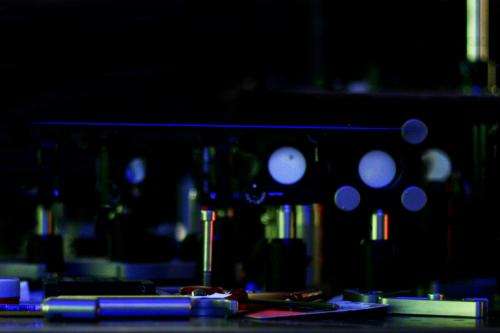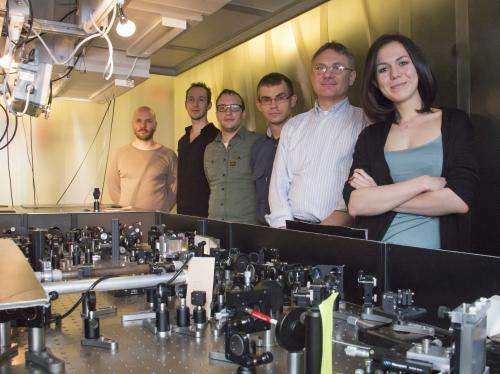Laser filaments in the air
Scientists from Vienna and Moscow have created a high-energy mid-infrared laser powerful enough to create shining filaments in the air. Such devices could be used to detect chemical substances in the atmosphere.
It looks a bit like a lightsaber from Star Wars: when an extremely intense laser pulse is sent through the air, it can focus itself, creating a narrow filament of light. By shooting such filaments into the sky and analysing back-scattered light, it would be possible to trace pollutants in the atmosphere. To achieve this, lasers with mid-infrared wavelengths are required. However, reaching the critical power to produce such a filament with mid-infrared laser beams is very difficult. At these wavelengths, laser filaments have only been produced in high pressure gas tubes. Now, an Austro-Russian research team has succeeded in building a new kind of mid-infrared laser which is so intense that it ignites laser filaments in the air at normal atmospheric pressure.
Air that Acts Like a Lens
Normally, a beam of light is diffracted and diverges as it propagates. In order to focus the beam, some sort of lens is needed. "An intense laser pulse can create such a lens in the air by itself", says Audrius Pugzlys (Photonics Institute, Vienna University of Technology). The refractive index of air depends on the intensity of the beam. This intensity is not uniform, it is highest in the centre of the beam. This creates a focusing lens in the air.
Photonics-team: Skirmantas Alisauskas, Giedrius Andriukaitis, Tobias Floery, Andrius Baltuska, Audrius Pugzlys, Valentina Shumakova (left to right).
"This laser-pulse-initiated lens acts back on the parent laser beam by focusing it and creating plasma, which then in turn tends to defocus the beam", says Skirmantas Alisauskas (Vienna University of Technology). The interplay between focusing and defocusing effects creates a narrow filament that can be dozens of centimeters or even a few meters long. By spatial and temporal shaping of the pulses, it is possible to control the position in the sky where the filament is created.
The Most Interesting Wavelengths are Infrared
"Once a shining laser filament is created, it generates broadband mid-infrared light, which can tell us about the chemical composition of the air", says Audrius Pugzlys. Many molecules absorb light in the mid-infrared spectral range in a very characteristic way, so that they can be identified. Therefore, powerful laser beams in the mid-infrared range are needed to ignite the filaments and to make remote atmospheric sensing possible. But for a long time, such mid-infrared lasers generating very short and high-energy pulses have not been available.
A team of scientists at the Photonics Institute of Vienna University of Technology has been working for years on designing a high-energy ultrashort pulse source. "For some time, we have already been able to ignite filaments in high pressure gas tubes filled with nitrogen or oxygen. But now, we have finally succeeded in boosting the pulse energy to such a level that filaments are produced in air at normal pressure", says Skirmantas Alisauskas. The experiment was conducted together with a research team from Russia, using a laser system which was installed in the Russian Quantum Centre in Moscow using the amplification technology developed in Vienna.
Next Step: A Laser in Mid-Air
The next steps are already being planned: In the lab, the team has demonstrated that it is possible to make the mid-infrared laser interact with nitrogen in such a way that it does not only create a shining plasma filament but that it turns the filament into a laser, shining a beam right back towards the infrared laser source.
"If we could obtain this effect in the filament in the atmosphere, we could create a laser in the sky. We would have two laser beams propagating along the same axis in opposite directions – one fired up by our laser source, the other fired back by the air itself", says Audrius Pugzlys. "If the molecules in between are hit by two different lasers at the same time, it is possible to analyse them very accurately via nonlinear scattering processes." The mid-infrared laser filament device could one day be used to measure the concentration of pollutants above a city or to remotely detect harmful substances after a chemical accident.
More information: "Mid-infrared laser filaments in the atmosphere," Scientific Reports 5, Article number: 8368, DOI: 10.1038/srep08368
Journal information: Scientific Reports
Provided by Vienna University of Technology

























